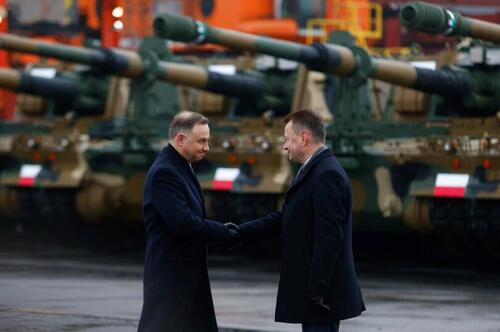
Authored by Katarzyna Stañko via Remix News,
Poland aims to create the largest land army in Europe, according to a report from French newspaper Le Figaro, with the paper’s analysis pointing out the colossal weapons contracts signed by Warsaw, including tanks, self-propelled guns, and missile launchers.
Poland is arming quickly and securing weapons at a frantic pace. Prior to contracts with South Korea, Warsaw ordered 250 American Abrams tanks to replace the old Soviet-era tanks it sent to Ukraine and other heavy equipment. The deal signed with the South Korean company Hyundai Rotem for the delivery of tanks will amount to four times the number of Leclerc tanks currently used by the French army.
Le Figaro noted that Polish Defense Minister Mariusz Błaszczak promised in July that Poland will have the “strongest land forces in Europe.”
The Polish government also plans to increase its number of servicemen to 300,000 by 2035 from the current 170,000. At the same time, the country aims to increase military expenditures in 2023 to 3 percent of its GDP, surpassing all other EU countries, including France, which is planning to reach 2 percent.
Despite the increase in land forces, Poland still falls behind in the air and naval branches compared to France and Britain. However, Warsaw is modernizing these branches of the military as well by signing agreements to receive F-35 fighters and FA-50s, as well as three British frigates and two espionage ships made by the Swedish Saab company.
“For Poles, the Russian threat was always present and will remain this way in the long run,” said former head of the European Defence Agency, Claude-France Arnould.
“Poles were on standby already during the NATO Summit in Bucharest in 2008.”
“Those armaments are the evidence of the triumph of the concept of strategic autonomy,” said Frederic Mauro of the International and Strategic Relations Institute.
The Polish government aspires to take on the role as the “leader of NATO’s eastern flank,” while South Korea offers a very attractive price-quality ratio, he said.
“The war of attrition in Ukraine showed how important having large quantities of inexpensive equipment is,” Mauro added. “Today, in Europe with the Ukraine war, we are speaking of a war economy. Having advanced weaponry is not enough, you need to have plenty of it, fast,” concluded the analyst.
Authored by Katarzyna Stañko via Remix News,
Poland aims to create the largest land army in Europe, according to a report from French newspaper Le Figaro, with the paper’s analysis pointing out the colossal weapons contracts signed by Warsaw, including tanks, self-propelled guns, and missile launchers.
Poland is arming quickly and securing weapons at a frantic pace. Prior to contracts with South Korea, Warsaw ordered 250 American Abrams tanks to replace the old Soviet-era tanks it sent to Ukraine and other heavy equipment. The deal signed with the South Korean company Hyundai Rotem for the delivery of tanks will amount to four times the number of Leclerc tanks currently used by the French army.
Le Figaro noted that Polish Defense Minister Mariusz Błaszczak promised in July that Poland will have the “strongest land forces in Europe.”
The Polish government also plans to increase its number of servicemen to 300,000 by 2035 from the current 170,000. At the same time, the country aims to increase military expenditures in 2023 to 3 percent of its GDP, surpassing all other EU countries, including France, which is planning to reach 2 percent.
Despite the increase in land forces, Poland still falls behind in the air and naval branches compared to France and Britain. However, Warsaw is modernizing these branches of the military as well by signing agreements to receive F-35 fighters and FA-50s, as well as three British frigates and two espionage ships made by the Swedish Saab company.
“For Poles, the Russian threat was always present and will remain this way in the long run,” said former head of the European Defence Agency, Claude-France Arnould.
“Poles were on standby already during the NATO Summit in Bucharest in 2008.”
“Those armaments are the evidence of the triumph of the concept of strategic autonomy,” said Frederic Mauro of the International and Strategic Relations Institute.
The Polish government aspires to take on the role as the “leader of NATO’s eastern flank,” while South Korea offers a very attractive price-quality ratio, he said.
“The war of attrition in Ukraine showed how important having large quantities of inexpensive equipment is,” Mauro added. “Today, in Europe with the Ukraine war, we are speaking of a war economy. Having advanced weaponry is not enough, you need to have plenty of it, fast,” concluded the analyst.
Loading…





